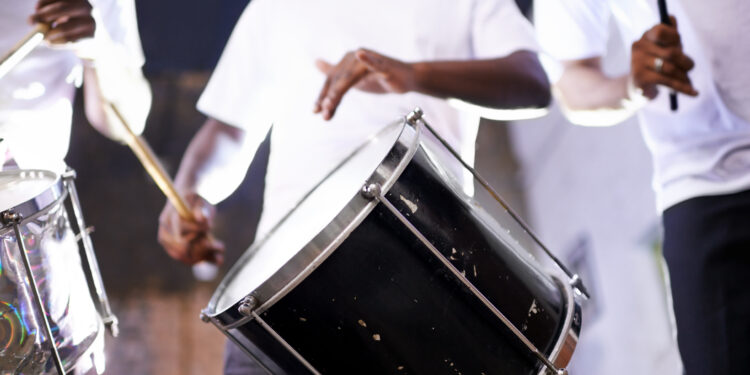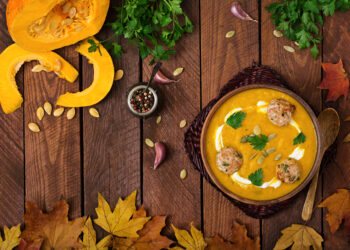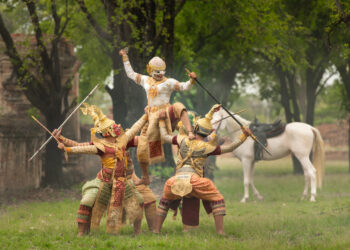“Tassa Drums vs Dhol: The Heartbeats of Indo-Caribbean Celebrations” — there’s something unmistakably magnetic about the sound of drums at a celebration. Long before the food arrives or the dancing begins, it’s the rhythm that announces joy, calls communities together, and makes the air hum with anticipation. In Indo-Caribbean culture, two percussive giants reign supreme: the tassa and the dhol. Each has travelled oceans, carried centuries of history, and adapted to the rhythm of new worlds — yet both remain central to the heartbeat of festivals, weddings, and street parades from Trinidad to Tooting.
These drums are not merely instruments; they are living archives of memory and movement. The tassa, with its high, sharp cadence, often leads processions through the Caribbean sun. The dhol, deep and commanding, drives Punjabi and Indo-Caribbean celebrations alike with its thunderous pulse. Together, they embody the sounds of migration, adaptation, and cultural endurance — proof that when people move, their music moves with them.
A Tale of Two Rhythms: From India to the Caribbean
The story of tassa and dhol is, in many ways, the story of Indo-Caribbean identity itself — one of survival, creativity, and cultural fusion. Both drums originated in India, but their paths to the Caribbean took shape through indentureship in the 19th century.
When Indian labourers were brought to colonies such as Trinidad, Guyana, and Suriname, they carried with them fragments of their home language, rituals, recipes, and, of course, rhythm. Among these fragments was the dhol, a barrel-shaped drum played with sticks, known for its deep bass and bright treble. In North India, the dhol was the heartbeat of Bhangra and harvest celebrations.
But the tropical Caribbean, with its African rhythms, Creole languages, and carnival spirit, soon transformed this musical inheritance. The tassa evolved as a smaller, higher-pitched descendant of the traditional nagara and dholak drums, adapting to local materials and musical contexts. Goat skin was replaced by synthetic heads; bamboo sticks gave way to flexible canes; rhythms grew faster, sharper, more urgent — like the new societies forming around them.
By the early 20th century, tassa had become synonymous with Indo-Trinidadian celebrations: weddings, Hosay processions, and Carnival bands. Meanwhile, the dhol — especially among Punjabis and North Indians in Guyana and Suriname- retained its ceremonial weight, often accompanying folk songs and dance.
The Tassa Beat: Carnival’s Wild Child
If the tassa drum had a personality, it would be the extrovert of the musical world — bright, flamboyant, and a little unpredictable. Played in ensembles called tassa groups, it’s usually paired with a bass drum and a cymbal, producing a dynamic range of tones that can be both hypnotic and exhilarating.
The most recognisable rhythms, or hands, have evocative names like dingolay, nagaara, and chutney soca hand. These aren’t just musical patterns; they’re emotional languages. A dingolay rhythm might signal pure joy and dance energy, while nagaara evokes a ceremonial gravitas rooted in Indian martial traditions.
During Hosay (the Indo-Trinidadian commemoration of Muharram), tassa drums lead processions through the streets, their staccato rolls echoing with devotion and defiance. At weddings, they announce the groom’s arrival and transform otherwise quiet suburban roads into scenes of a festival. And in modern Chutney Soca — that irresistible fusion of Indian melodies and Caribbean tempo — tassa remains the percussive backbone.
Even in the UK, tassa has found new life. Indo-Caribbean communities in London, Birmingham, and Leicester have formed tassa bands that perform at melas, Notting Hill Carnival, and Diwali celebrations. When those drums strike up, you can feel the Caribbean heat ripple through the English drizzle.
The Dhol: The Deep Pulse of Tradition
If tassa is carnival’s wild child, the dhol is the dignified elder — thunderous, commanding, and deeply rooted in tradition. Originating from Punjab and North India, the dhol travelled across the oceans with migrants and evolved into the soundtrack of celebration across Indo-Caribbean homes.
Played with two sticks — one heavy (dagga) for the bass, and one thin (tilli) for the treble — the dhol produces a rhythm that’s both grounded and exuberant. It’s the drum that makes wedding processions impossible to ignore and gives Bhangra its irresistible drive.
In the Caribbean, particularly among Surinamese and Guyanese Indians, the dhol retained its role in cultural and religious events. It became an anchor during taaza (ritual drumming sessions), Hindu weddings, and Phagwah (Holi) festivals, blending Indian beats with local Caribbean flair.
Today, dhol players are cultural ambassadors in their own right, performing everywhere from London’s Trafalgar Square during Diwali to Caribbean-style Carnivals in Toronto and New York. In the UK, dhol has even transcended cultural lines, fusing with Afro-Caribbean soca, reggae, and electronic music, showing that rhythm really has no borders.
When Rhythms Meet: Tassa and Dhol in Harmony
Though tassa and dhol have distinct origins, it’s increasingly common to see them sharing the same stage — especially in diaspora celebrations where Indo-Caribbean and South Asian communities intersect. The result? A soundscape that’s as diverse as the modern British identity itself.
At events like London Mela or Caribbean Fusion Fest, tassa groups and dhol troupes often perform side by side, tassa leading the rapid-fire roll, dhol grounding the groove with its resonant bass. The interplay mirrors the cultural blending that defines Indo-Caribbean music: Chutney Soca, Chutney Bhangra, even tassa-led versions of Bollywood hits.
In these moments, boundaries blur. What began as two separate instruments becomes a conversation between histories — one forged in indentureship, the other in migration — yet both pulsing with the same desire to celebrate, survive, and belong.
The Diaspora Beat: From Port of Spain to Peckham
Walk through a British Indo-Caribbean event and you’ll hear the familiar clash of sounds that bridge continents. Tassa at a Trinidadian wedding in Southall, dhol echoing down a Leicester high street during Holi — these are not just performances; they’re declarations of cultural endurance.
For the second and third generations of Indo-Caribbeans in the UK, these drums are more than nostalgic artefacts. They’re links to heritage that continue to evolve. Young musicians now mix tassa with EDM, dhol with soca, and even use digital sampling to layer ancient rhythms into modern tracks.
More Than Music: The Emotion Behind the Beat
What gives the tassa and dhol their true power is not merely their sound, but the emotion they embody. These drums punctuate life’s most significant moments — the groom’s triumphant arrival, the bride’s poignant farewell, the victorious sweep of Carnival, and the final reverent beats of a religious procession.
When the tassa rolls or the dhol resounds, they bridge generations — grandparents who remember ancestral homelands, parents who built new lives across oceans, and children who come to understand identity through rhythm. It is heritage not spoken, but felt; a story carried in vibration rather than words.
As one UK tassa player aptly remarked, “You don’t just play tassa — it plays you.” And anyone who has felt that unmistakable thump reverberate through their chest during a street parade would surely agree.
The Future: Keeping the Drums Alive in Britain
As younger generations of Indo-Caribbeans come of age in a richly multicultural Britain, the preservation of tassa and dhol traditions rests on visibility, education, and creative adaptation. Encouragingly, the signs are promising.
Tassa bands such as the West London Tassa Crew and Trini Vibes UK continue to bring their infectious energy to festival stages across the country, while dhol players collaborate with an eclectic range of artists — from Caribbean steelpan ensembles to electronic music producers. On digital platforms like TikTok and Instagram, short tassa breaks and dhol rhythms are finding new life, introducing these sounds to audiences far beyond the Indo-Caribbean diaspora.
Recognition is also growing for these instruments as vital expressions of cultural heritage. In Trinidad, tassa drumming has been nominated for UNESCO heritage status, while UK-based Indo-Caribbean organisations are advocating for greater inclusion of these traditions within mainstream music education. The aim is not merely preservation, but celebration, ensuring that future generations can tell the difference between a spirited dingolay and a thunderous dhamaal, and take pride in loving both equally.
Closing Notes!
In the end, the tassa and the dhol are not rivals — they’re relatives separated by oceans, reunited through rhythm. One speaks in quicksilver bursts, the other in resonant waves, but both tell stories of migration, resilience, and joy.
From the sugar estates of the Caribbean to the high streets of Britain, their beats continue to pulse through Indo-Caribbean life, a sound that refuses to fade.
So, the next time you hear the tassa’s chatter or the dhol’s thunder, stop for a moment. Feel the heartbeat beneath it. It’s the sound of generations keeping time — to memory, to movement, and to celebration.
And for more stories that celebrate Indo-Caribbean culture in all its rhythm and colour, follow CurryBien — your home for food, family, and the sounds that keep our heritage alive from Port of Spain to Peckham.




















